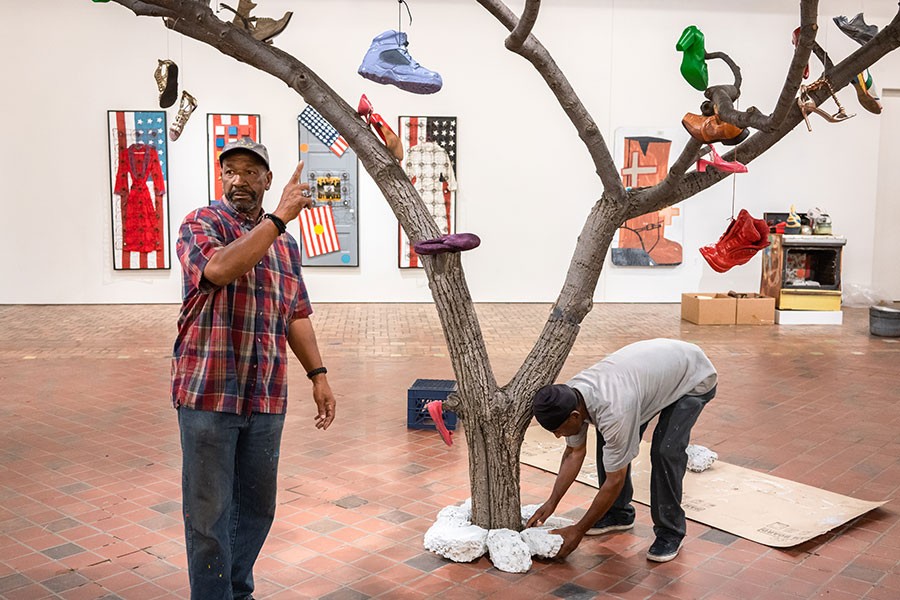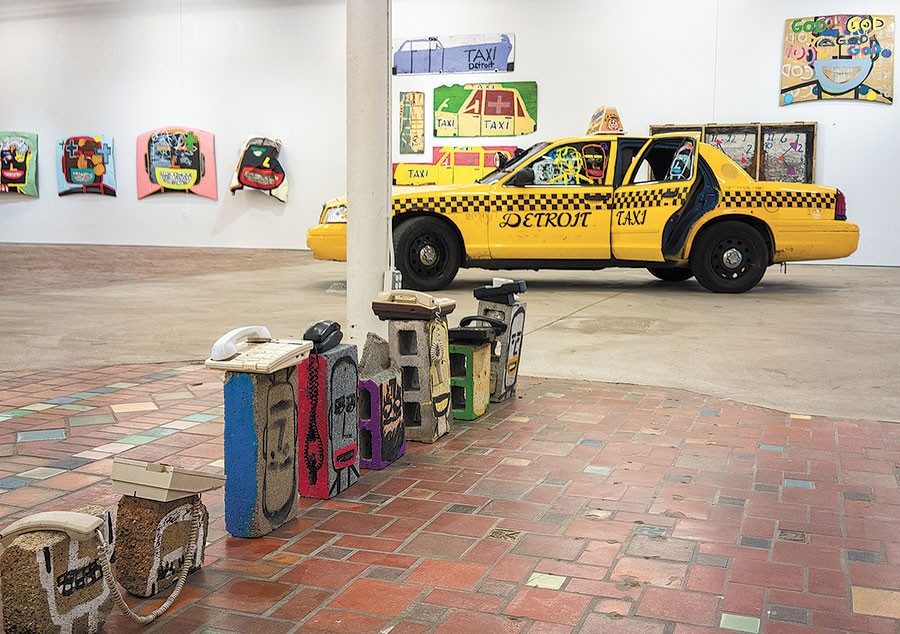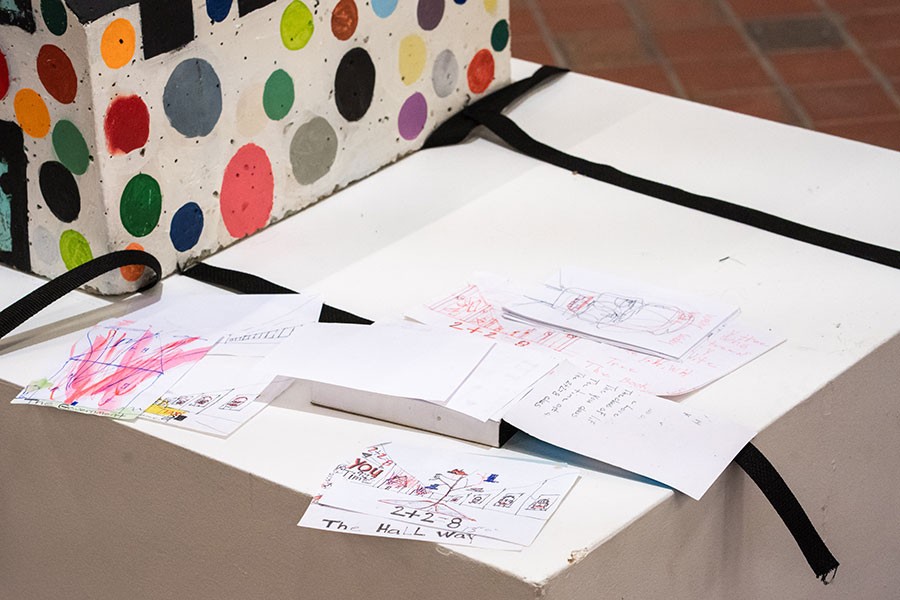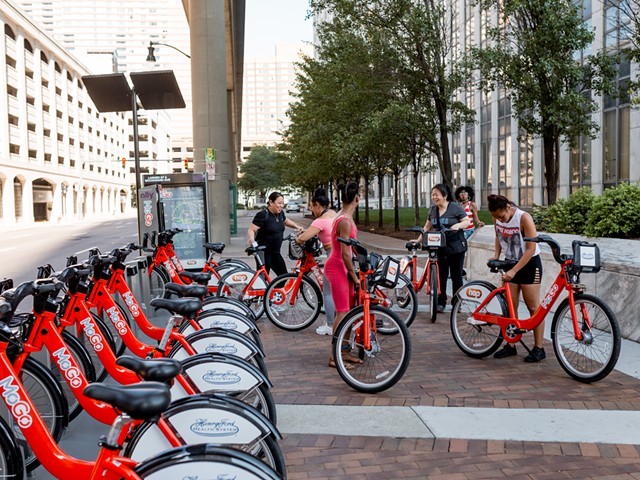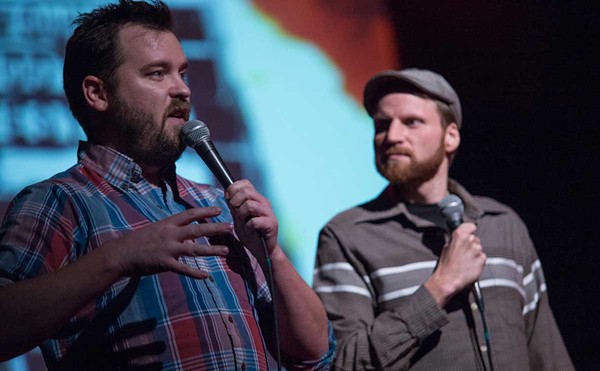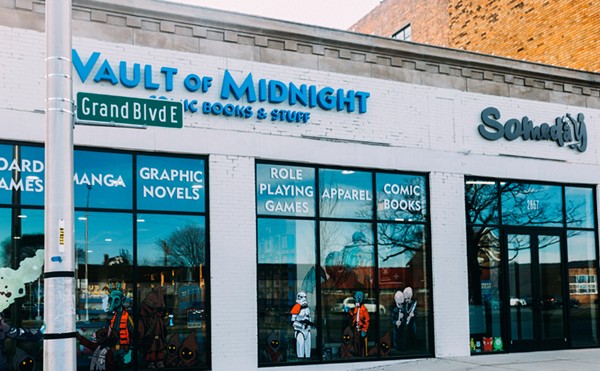
In the case of Tyree Guyton, one gets the sense that the artist might see time as a flat circle. At the very least, he certainly believes in the power of a flat circle.
Guyton's career started in 1986, when he began painting pastel polka dots on his grandfather's house on Heidelberg Street in Detroit's deteriorating McDougall-Hunt neighborhood. That was the beginning of what would become known as the Heidelberg Project, a neighborhood-wide installation with Guyton using reclaimed materials — furniture, appliances, toys, and more — to transform the abandoned and decaying houses into a sort of post-apocalyptic wonderland, sparking plenty of art-or-eyesore debates along the way.
There are plenty of reasons to believe Guyton won the debate. We meet Guyton at the Museum of Contemporary Art Detroit, where the artist is directing the installation of his upcoming exhibition, 2+2=8 Tyree Guyton: Thirty Years of Heidelberg, which opens at the museum on Friday.
Time is obviously on Guyton's mind, with the Heidelberg Project celebrating 30 years in 2016. The exhibition is broken up into sections offering a trip through Guyton's various styles and bodies of work, painted in his signature childlike manner. One section has car hoods painted with bright, smiling faces. Another features clock faces painted on boards, some with more than two hands. A large lavender polka dot is painted on the white walls of MOCAD's otherwise stark white gallery wall. On Guyton's right forearm is a faded polka dot tattoo.
"We have a way of growing up through time," he says as he guides us through the exhibition. "And so I'm going to say I'm a little more experienced. I'm a little more courageous. What is art? To me, I've proven it can be anything. I know a little bit more."
But when asked if this show would be categorized as a retrospective, Guyton brushes the question off. "I'm talking about this damn journey," he says. "It's been fun. It's been exciting." He gestures at the faces. "It's been that period," he says. "It's been this period," he gestures at the clocks. "It's been that time, it's been now. So that's what you see here."
One helper places white rocks around the base of a large tree, which has somehow been transported from the Heidelberg Project and installed in the middle of the gallery. Meanwhile, Guyton adjusts shoes hung from its branches by their laces. He calls the piece "Soul Tree."
"The tree concept started from my grandfather," Guyton says. "My grandfather said he would see people hanging from trees when he was a kid. So I want to talk about that."
Guyton hangs more shoes from the tree. One is a boot he says is from Desert Storm. There's also a pair that he says belonged to his mother.
"My mom passed last year," he says, looking at the shoes. "I can see her in these." He picks up a patent leather shoe. "I believe it would be safe to say this was a pimp shoe," he says.
He pauses, looking at the tree. "There are many ways to hang people today," he laughs. "Lots of ways now."
Guyton would know a thing a or two about persecution. In the '90s, the city twice ordered parts of the Heidelberg Project demolished. In 2013 and 2014, a suspected arsonist or group of arsonists destroyed parts of the project in a total of 12 fires.
But even as he has been persecuted, Guyton's star as an artist has also risen, getting invited to exhibit his work in places like Shenzhen, China and Basel, Switzerland throughout the years. And as Guyton's career has ascended, so has Detroit — or parts of it, anyway.
Last year, Guyton was forced to move out of his Midtown office and studio where he lived and worked for nearly a decade after the building was sold for $1.2 million. In his time there, Guyton covered the boarded-up abandoned building next door with paintings of shoes, where they sat for years. When he moved, he sold off dozens of the paintings, fetching as much as $2,500 for one of them. Now, his former studio is Second Best, a hipster faux-dive bar that sells a $10 40-ounce Miller High Life, served in Champagne glasses. Guyton has since found a new studio, located closer to the Heidelberg Project.
What's up with the shoes? "Here we are in this beautiful, complex world, and everyone's going somewhere in time," he says. "So you have big shoe, little shoe, red shoe, green shoe. Everything's moving."
‘Nothing is just thrown together. Every single thing is thought about. Every material goes through a process where he goes, “Does this make sense?”’
tweet this
The Heidelberg Project has been a story of continuous birth and rebirth. When the city bulldozed his houses, Guyton kept building. After the fires warped and charred car hoods he had previously painted on, Guyton just painted new faces on them and put them in a show at Detroit's Inner State Gallery — repurposing his own art much like the way he repurposed the houses and other found objects in the McDougall-Hunt neighborhood.
On one of MOCAD's walls, Guyton has painted a large, crude mural depicting a burning house. Next to it, he has scrawled the words "the conspiracy."
When asked about the fires, Guyton turns serious. "I'm going to keep moving on," he says. "All I have to say to my enemy is don't fuck with me. Just like that. Because I'm an artist, and I have a lot of tricks up my sleeve."
Guyton points to a polka-dotted phone booth on the gallery floor. He says he retrieved it from the 1991 demolition. "Heidelberg is here," he says. "I thought, I'm going to save it, because one day I'm going to be able to put it in a museum on display. So this is Heidelberg." He gestures around the gallery. "It's all Heidelberg."
Guyton calls it "Heidelbergology." He has another phrase for it, too.
"I'm like a mad scientist, working on two plus two equals eight," he says.
Show curator Jova Lynne elaborates. "When I first met Tyree, I was like, 'What's two plus two equals eight?'" she says. "He said, 'It's anything you want it to be. It's making something out of nothing.'"
Lynne says the goal of the exhibition was not to re-create the Heidelberg Project inside of MOCAD, but rather "to celebrate it and its 30-year legacy, and to give people a new way of looking at it."
Aside from "Soul Tree," the other centerpiece of the show floor is an actual taxi cab, painted with Guyton's colorful grinning faces. It's Guyton's signature mix of beauty and decay: The colors are bright, but the windshield is smashed. In the backseat is a painting of Jesus, a hula hoop, and the brick that was thrown through the window.
"I was working on it and someone threw a brick," he says. "And I said, 'Damn, you did me a favor.'" Guyton says the piece is titled, "Why Do You Hate Me?" "Because we hated Jesus," he laughs. "We killed him."
Nearby are stylized taxi cabs painted on boards. "Where you want to go?" he responds when asked about the motif. "Can I go to a place where there's no war, a place where there's no poverty or homelessness? Do I have to die to go there? Or can I take a taxi?"
Guyton may appear at times to be making shit up as he goes, but there is a method to his madness. To prove it, he asks a helper to retrieve a sketchbook from his car. Inside is a two-page spread doodle, showing the room we are standing in as it is now, drawn in perspective.
"Nothing is just thrown together," Lynne says. "It's so intense. Every single thing is thought about. Every material goes through a process where he goes, 'Does this make sense?' To see and hold these things, it's a spiritual practice in a way."
Guyton's naive style sometimes gets his work lumped in with "outsider art." But as MOCAD executive director Elysia Borowy-Reeder points out, an outsider artist is someone who is self-taught. Before the Heidelberg Project, Guyton attended the then-Center for Creative Studies in Detroit, and was awarded an honorary doctorate in fine art from the College for Creative Studies in 2009.
"He is sophisticated, but somewhere along the lines his method of working was viewed from the lens of a populist art form," she says. "I always thought no, this person has been trained as a fine artist. You can see that in the way he moves his brush, and the way he uses his environment." A second exhibition of Guyton's work, titled Process, will open at MOCAD on Saturday, Oct. 13, showcasing the artist's fine art side, including portraits, sketches, and photographs.
"Process is really about his solo practice works that hint at Heidelberg, but aren't actually at Heidelberg," Lynne says. "Although Heidelberg is a key part of his story, I think there's a lot about his practice that people haven't seen and don't know about."
Beyond that, Rachel Adams — a curator for the UB Art Galleries in Buffalo, who did her master's work studying the Heidelberg Project — sees Guyton's work not just as a body of artwork but as an act of resistance or civil disobedience.
"He was just one person, and he really made an immediate difference in the lives of everyday people," she says. "And he continued to do that even after the city tore down his projects. I think it's hard to imagine how upsetting that could be. There are only certain people who I think could do that. Like, 'That was the worst day of my life, and I have to go outside and do it again.' And it could happen again." Adams will give a talk at MOCAD titled "The History of Heidelberg as Rebellion" at 1 p.m. on Saturday, Sept. 8.
‘The main reason why I saw the need to do something is because I was kind of tired of waiting on government. But those days are over now.’
tweet this
But Guyton's battle with the city could be over. "The main reason why I saw the need to do something is because I was kind of tired of waiting on government," Guyton says of the Heidelberg Project. "But those days are over now. I've proven my point. The city has also proven their point. All I'm saying is, what can we do together? I have a new way of looking at government, and hopefully they have a new way of looking at the Heidelberg Project. We've been around for a long time, and we have proven so many points. It's a magnet and it brings people there to the city, and it brings people to the neighborhood. If it wasn't there they wouldn't come."
On that point, Guyton offers a John F. Kennedy quote. "It's not what the government can do for you, but what can you do for government," he says. "I'm just doing my little part."
Jenenne Whitfield, Guyton's wife and also the Heidelberg Project's chief executive officer, says the studio move is partially what has helped guide the next phase of the Project, which they have dubbed Heidelberg 3.0. Part of that involves dismantling parts of the project, bringing them into gallery settings and consolidating the existing Project into a more permanent location. In October, several pieces will appear across the state as part of Grand Rapids' ArtPrize competition.
"What happened in this last year is pretty much a Heidelberg explosion," Whitfield says. "So you are seeing Heidelberg being removed from the site and going to various places."
But another part of Heidelberg 3.0, Whitfield says, is fighting against the forces that forced Guyton to move from Midtown. From Oct. 11-14, the Heidelberg Project will host "360° of Heidelberg," a conference featuring arts experts, community leaders, and more, to be held at various venues around the city. "The concept is that there are some things to be learned from what we've experienced," she says. "There are many artists that have experienced some aspect of what we have experienced in these 32 years. So we're using Heidelberg as a case study to explore the need for a more sustainable arts community in Detroit. We're taking on a much bigger responsibility than just our own."
The way Whitfield sees it, artists are driving Detroit's rebirth. "The thing about it is what's making the city of Detroit so lively and attractive and interesting for younger people is the energy of the city," she says. "The energy of the city is promoted by the artists. It is a fact and we are helping to define Detroit's future, and our place in its future is important."
But time and again, the same cycle repeats: artists make a neglected neighborhood hip and attractive, and are then pushed out to make way for developments like luxury apartments. Whitfield wants to change that.
"What I'm saying is let's build an artist community where not only do the artists work, but they also have ownership," she says. "They are never to be pushed out again. They own the space, they activate the space. If artists are actually given the opportunity for artists to own and to live in an area, that has a reverberating effect."
Whitfield says that even though Mayor Mike Duggan's administration has been friendlier to the Heidelberg Project than previous administrations, she still sees room for improvement.
"I've never met Mike Duggan, and neither has Tyree. That's interesting," she says. "However, we are working with people within the city that are attempting to address this in a way that the mayor can swallow it."
She says she understands Duggan "is not an arts person" — a reference to the mayor's crackdown on graffiti and other unauthorized street art, as well as the fact that the city has not had a Department of Cultural Affairs since the Dennis Archer administration. "But I certainly think if he looked at the economic benefit behind the arts community, he could change his tune," she says.
"This is an artistic revolution," she says. "That's what we're after. We got nothing to lose. Heidelberg's been through it all."
As for what Heidelberg 3.0 will look like, Lynne can only surmise. "I think [Guyton's] thinking about what the next 30 years look like," she says. "And maybe it doesn't need to be just him. It's him and it's his, but it's also not anymore. It belongs to all of us. It belongs to the city of Detroit. So I think he's being really intentional about how that transition happens."
On that matter, Guyton, who turned 63 this year, is hard to pin down. "I don't know, but I am very optimistic, I know that," he says. "I'm just taking it one day at a time. Today I'm down here at MOCAD, and I'm going to give this show my very best. And tomorrow will take care of itself."
He laughs. "I have free time now. I might die tomorrow."
2+2=8 Tyree Guyton: Thirty Years of Heidelberg opens on Friday, Sept. 7 at MOCAD; 4454 Woodward Ave., Detroit; 313-832-6622; mocadetroit.org; 6-7 p.m. members-only preview; 7-11 p.m. opening reception. Rachel Adams will give a talk on the History of Heidelberg as Rebellion at 1 p.m. on Saturday, Sept. 8. Guyton has an artist talk at the museum at 7 p.m. on Thursday, Nov. 15. All events have a $5 suggested donation, free for members. Both shows run through Jan. 6.
Get our top picks for the best events in Detroit every Thursday morning. Sign up for our events newsletter.

